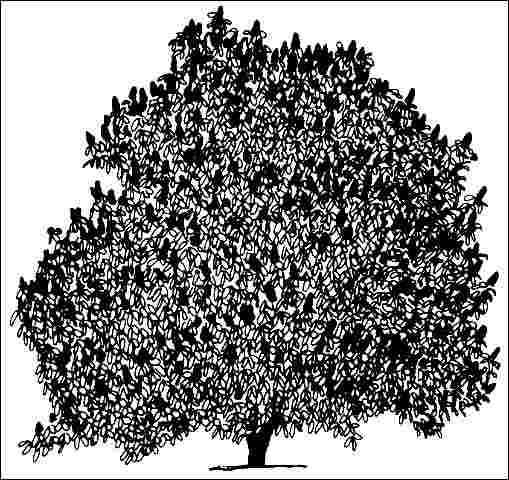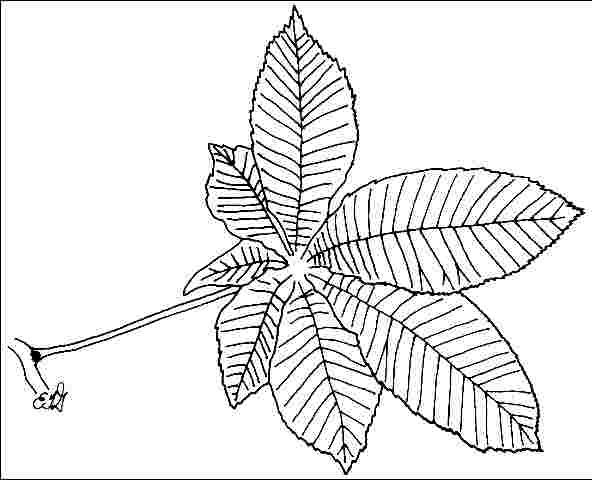Aesculus x carnea 'Briotii': Ruby Red Horsechestnut1
Introduction
This hybrid of Aesculus hippocastanum and Aesculus pavia has very large, dark green leaves composed of five to seven leaflets, and will ultimately reach a height and spread of 35 to 50 feet but grows slowly. Although deciduous, ruby red horsechestnut does not produce any appreciable fall color and is well suited for use as a specimen. The tree is quite striking with dark green, coarse-textured foliage. Pyramidal in shape when very young, red horsechestnut develops slowly into a round, very dense shade tree by five to seven years of age, and is outstanding in the landscape for its beautiful springtime display of blossoms. The multitude of deep scarlet flowers in erect, 10-inch-long panicles at each branch tip are quite attractive to bees and hummingbirds. The prickly seedpods that can be messy on the original hybrid are nearly absent on this cultivar, making it better suited than the species for urban street tree planting.

General Information
Scientific name: Aesculus x carnea
Pronunciation: ESS-kew-lus x KAR-nee-uh
Common name(s): Ruby red horsechestnut
Family: Hippocastanaceae
USDA hardiness zones: 5A through 7B (Fig. 2)
Origin: not native to North America
Invasive potential: little invasive potential
Uses: street without sidewalk; sidewalk cutout (tree pit); tree lawn 3–4 feet wide; tree lawn 4–6 feet wide; tree lawn > 6 ft. wide; parking lot island 100–200 sq. ft.; parking lot island > 200 sq. ft.; specimen; shade; screen; highway median
Availability: somewhat available, may have to go out of the region to find the tree

Description
Height: 35 to 45 feet
Spread: 35 to 45 feet
Crown uniformity: symmetrical
Crown shape: pyramidal, round
Crown density: dense
Growth rate: slow
Texture: coarse
Foliage
Leaf arrangement: opposite/subopposite (Fig. 3)
Leaf type: palmately compound
Leaf margin: serrate
Leaf shape: oblanceolate
Leaf venation: pinnate
Leaf type and persistence: deciduous
Leaf blade length: 4 to 8 inches
Leaf color: green
Fall color: no color change
Fall characteristic: not showy

Flower
Flower color: pink, red
Flower characteristics: very showy
Fruit
Fruit shape: no fruit
Fruit length: no fruit
Fruit covering: no fruit
Fruit color: no fruit
Fruit characteristics: no fruit
Trunk and Branches
Trunk/bark/branches: branches droop; not showy; typically multi-trunked; thorns
Pruning requirement: needed for strong structure
Breakage: resistant
Current year twig color: brown
Current year twig thickness: thick
Wood specific gravity: unknown
Culture
Light requirement: full sun
Soil tolerances: sand; loam; clay; acidic; well-drained
Drought tolerance: moderate
Aerosol salt tolerance: moderate
Other
Roots: not a problem
Winter interest: no
Outstanding tree: yes
Ozone sensitivity: unknown
Verticillium wilt susceptibility: resistant
Pest resistance: resistant to pests/diseases
Use and Management
Leaf and flower litter in the summer and fall may be objectionable to some people since the leaves are large and decompose slowly. Makes a great median street tree when provided with some irrigation during drought.
Ruby red horsechestnut will grow in full sun or light shade and prefers moist, well-drained, acid soils but grows in slightly alkaline soil. Plants are moderately tolerant to drought, wind, and salt, and resist the heat of the South very well. It holds up well in urban areas, even in restricted and compacted soil spaces. Red horsechestnut appears to be less susceptible to disease than either of the parents. Trunk bark may crack when exposed to the direct sun, so keep it shaded as much as possible by leaving lower branches on the tree and don't over-prune the tree, exposing the trunk suddenly to direct sun. The tree usually requires little pruning to develop a good form.
The cultivar 'Rosea' has pink flowers. 'O'Neil's Red' has double red flowers.
Pests and Diseases
No pests or diseases are of major concern, although this plant has not been thoroughly tested in the United States. Probably scorches less than Aesculus hippocastanum, and should be planted in its place.


